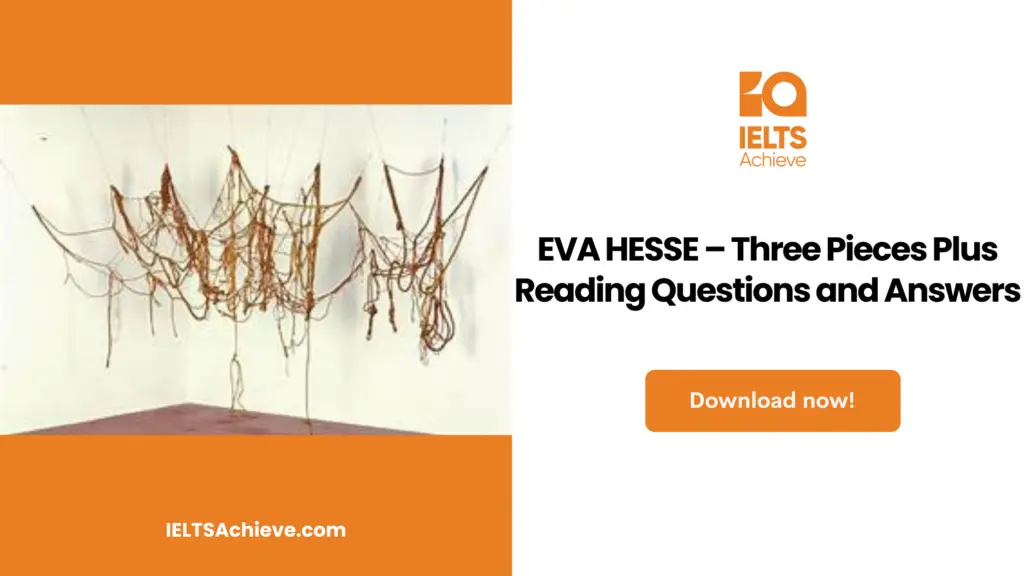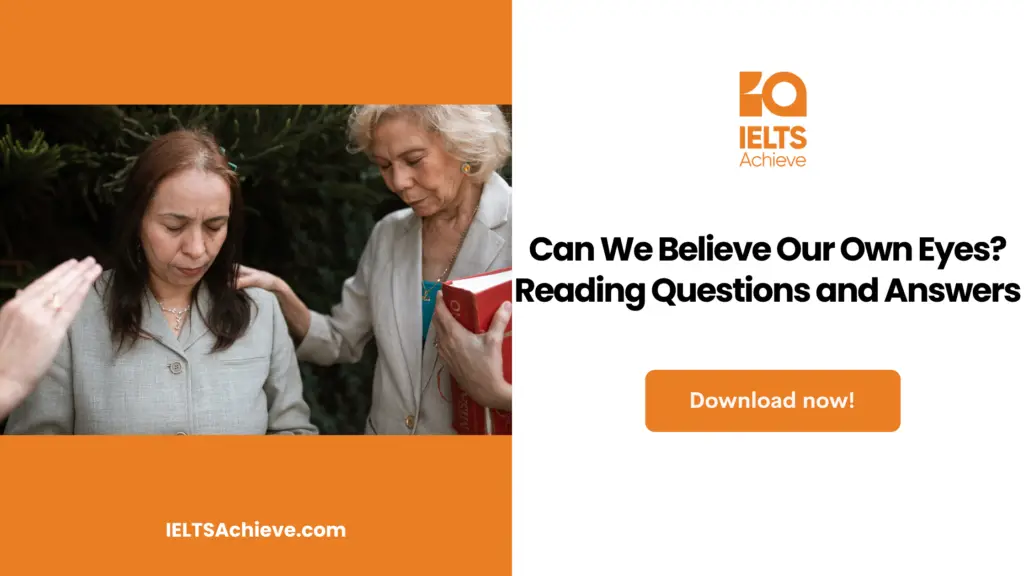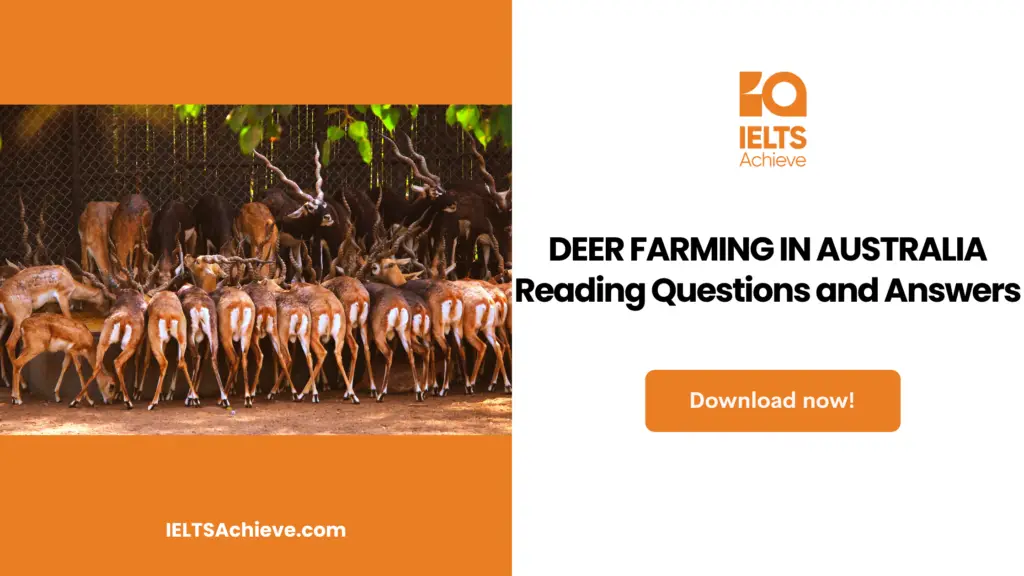The Blog post contains the following IELTS Reading Questions:
- IELTS Reading Yes/No/Not Given
- IELTS Reading Multiple Choice Questions
Stay informed and prepared for success – Explore our comprehensive Reading Test Info page to get valuable insights, exam format details, and expert tips for mastering the IELTS Reading section.
IELTS Reading passage – EVA HESSE – Three Pieces Plus

EVA HESSE – Three Pieces Plus
The Guggenheim Art Gallery, New York.
In one corner of the room is a mass of tangled rope suspended from the ceiling with some sections dangling to the floor; the first of three encountered pieces of work that have a resounding impact on the viewing public. It stops one in one’s tracks: how dare it be there – this mess of nothing! It is like arranged chaos: that is, the confused mixture of varying sizes of rope, dipped in latex, looks as though it might collapse in a heap on the floor at any moment. At the same time, it is held up and in place by a series of fine wires and hooks, giving it a strange sense of … order.
A deliberate challenge to the forces of gravity. It is a shambles. It makes one laugh. It is played. It is drawing in the air! Maybe it can move or dance about! Yet, it is hardly there, like something imagined.The materials are cheap and disposable. Impermanent, like … the people looking at it. But it is very definitely present! It has a presence. You can see that people want to walk into it and become a part of it – but alas! The gallery guard is hovering nearby.
To the left of this piece, running along the wall, in two rows on top of each other, is a long series of lid-less boxes. They are mounted at average nose height and are made of fibreglass which gives them a shiny, almost moist, appearance. They are the colour of murky water, absorbing the gallery light with an opacity similar to that of mucus or tree gum.They look as though they might be soft and malleable to touch, with their irregular edges and non-conforming sides. This gives the overall impression that they could fall in on themselves or slide down the wall. The structure is puzzlingly familiar, similar to things in the world, and yet it is not like anything in particular.
In the adjacent corner is the third piece, consisting of a collection of nine cylindrical open-ended objects, slit part way from end to end. They give the appearance of being randomly placed – some lying, some leaning on the wall or on each other- all seeming somehow to be related. Like the boxes, they are a multiple of each other. Made of fibreglass with a shiny surface they look almost like abandoned pods that had once been alive. The associations seem to jump around in one’s head, running between sensations of delight and pleasure, violence and discomfort.
One has to bend down to be with them more. Driven by the desire to physically interact, one is almost forced to stop further so that one can touch, or indeed taste, this intriguing surface; but no, the guard is there.The visual language apparent in these artworks is unfamiliar, as is the artist, Eva Hesse. Her work is as exciting as it is disturbing. For many, Hesse’s sculpture refers essentially to the body. This, perhaps, does not seem surprising when it is in relation to the body that women are generally assessed. Hesse died of a brain tumour in 1970 at the age of 34. It must be an inescapable inevitability, therefore, that her work was read in the context of its time where it has, until recently, been largely abandoned.Given the influence of feminism on our cultural consciousness since that period, it seems paramount that we avoid, or at the very least attempt to avoid, those dramatic facts about her life and family history.
We may then be freed from a limited and narrow translation of her art.Hesse’s work is much more ambiguous and funny than some rather literal readings would have us believe. Perhaps it is precisely because her use of metaphor in her work is so subtle that it escapes the one-line definitions we so love to employ.We are now, more than ever, hungry for the cult of ‘personality’. While Hesse and others before and since can more than fill that demand, we seem in danger of focusing on the life of the artist and not on the life of the art.When looking at Hesse’s sculpture, drawings and paintings, the most interesting and challenging aspects lie just there – within the work. And this must be the starting point for any interpretation, not her complex life or untimely death.
Unlock your full potential in the IELTS Reading section – Visit our IELTS Reading Practice Question Answer page now!
Recommended Questions:
Renewable Energy IELTS Reading Question with Answer
Questions 31-36
Do the following statements agree with the information given in Reading Passage 93? In boxes 31-36 on your answer sheet, write:
YES if the statement agrees with the claims of the writer
NO if the statement contradicts the claims of the writer
NOT GIVEN if it is impossible to say what the writer thinks about this
Example Answer
The Guggenheim Art Gallery is in New York. Yes
31 The first piece of Hesse’s art has little effect on visitors to the gallery.
32 The order inherent in the first piece of Hesse’s art is essential to the understanding of her work.
33 The second piece of art by Hesse is inferior in several significant ways to the first.
34 The second piece by Hesse has several design faults that attract the public.
35 The third piece of work arouses different emotions.
36 Of the three pieces of Hesse’s work described, the first is the writer’s favourite.
Want to excel in identifying the writer’s views and claims? Click here to explore our in-depth guide on how to accurately determine Yes, No, or Not Given in the IELTS Reading section.
Question 37-40
Choose the appropriate letter A-D and write it in box 30 on your answer sheet.
37 According to the writer, Eva Hesse
A. is not a well-known artist.
B. is very familiar, as is her work.
C. is not a good artist.
D. is strongly attracted by visual language.
38 The writer concludes that
A. Hesse’s work is timeless.
B. the understanding of Hesse’s work has until recently been interpreted only in the context of its time.
C. Hesse’s work is a product of her time and is not relevant to the modern world.
D. Hesse’s work is easy to read.
39 The writer thinks that it is ……………… to define Hesse’s work.
A. not difficult
B. essential
C. not important.
D. not easy
40 In the present climate,
A. we may lose sight of Hesse’s art and focus on her life.
B. personality is very important.
C. art cults are in vogue.
D. we may lose sight of Hesse’s life and focus on her art.
Ready to improve your performance in Multiple Choice Questions (MCQs)? Click here to access our comprehensive guide on how to tackle MCQs effectively in the IELTS Reading section.
Unlock your full potential in the IELTS Reading section – Visit our IELTS Reading Practice Question Answer page now!
Recommended Questions:
Renewable Energy IELTS Reading Question with Answer
Answer
31. No
32. NOT GIVEN
33. NOT GIVEN
34. NOT GIVEN
35. YES
36. NOT GIVEN
37. A
38. B
39. D
40. A

We hope you found this post useful in helping you to study for the IELTS Test. If you have any questions please let us know in the comments below or on the Facebook page.
The best way to keep up to date with posts like this is to like us on Facebook, then follow us on Instagram and Pinterest. If you need help preparing for the IELTS Test, join the IELTS Achieve Academy and see how we can assist you to achieve your desired band score. We offer an essay correction service, mock exams and online courses.

